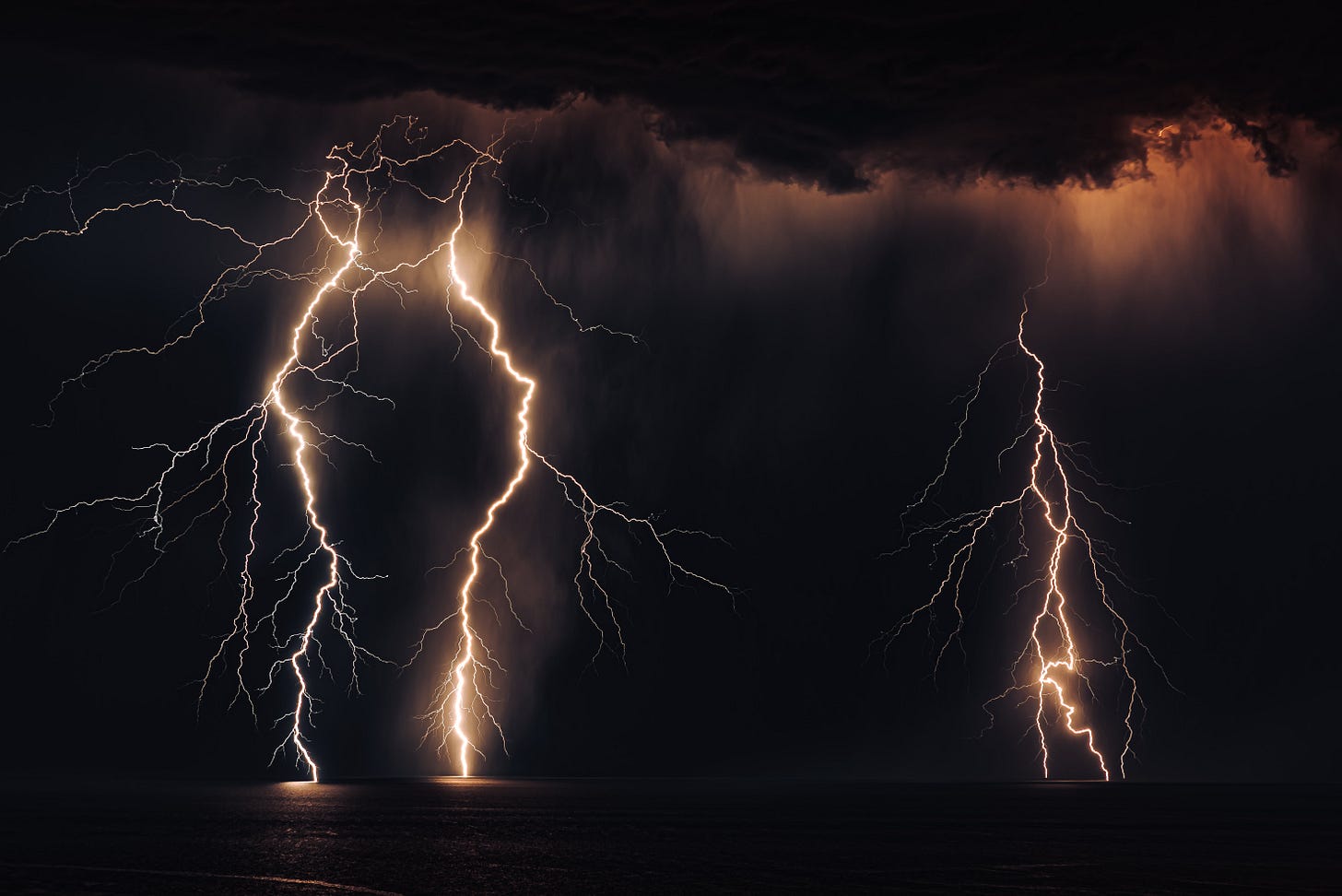On a recent Saturday morning, I was peacefully reading on my couch when a sudden rumble lightly shook my apartment. Was it the garbage truck shifting a dumpster around outside or a car with a modified exhaust zooming by my building? Nope…it was thunder! Lightning is relatively rare in my neck of the woods, so I rushed to my window in the hopes of catching a glimpse of any additional strikes. As I scanned the horizon and enjoyed the sound of a few more distant rumbles, I got to thinking, “Why does thunder happen?”. Specifically, why does lightning produce a sound at all? And why is it so loud?
What is lightning and why does it happen?
If we wish to be thorough, we must first understand what lightning actually is in the first place. I get that it’s electricity, but what mechanisms cause this flash of intense energy to appear? Well, whip out your microscopes, because we’re going to the atomic level to find the answer!
As you know, all things in our universe are made up of atoms. Each atom is either positively or negatively charged based on the number of electrons it has orbiting its nucleus (center, like the earth orbiting the sun). If it has more electrons than protons, it’s negatively charged, and if it has more protons than electrons, it’s positively charged. The movement of electrons between atoms is what generates the electricity we see.
With all that scientist talk out of the way, we can get back to the lightning. When tall storm clouds form, there is a lot going on inside the cloud itself. Air that is rising inside the cloud (the updraft) brings water droplets with it. Meanwhile, descending air (the downdraft) is bringing water droplets that have been frozen by the colder air in the upper atmosphere down towards the bottom of the cloud. In this dance of airflows and varying temperatures, the ice and water caught in the chaotic dance collide with each other and strip away electrons. This process results in separate fields of highly negatively charged matter and highly positively charged matter inside the cloud.
Now the stage is set for Thor to work his magic, or in a more likely case, for science to do its thing. Science tells us that nature prefers a neutral charge, so it will try to equalize protons and electrons when possible. So, if we have negatively charged fields and positively charged fields within a cloud, how do you think nature will correct this charge imbalance? That’s right…LIGHTNING! Or to put it more scientifically, the rapid (like, super rapid) exchange of electrons between positively and negatively charged fields.
But wait, if all this is happening inside the cloud itself, why does lightning strike the ground? Good question, hypothetical reader! When the highly charged field is towards the bottom of the cloud (often negatively charged), like the protagonists in many romcom movies, it attracts its opposite. A negatively charged field in the cloud will attract positively charged fields on the ground and a lightning strike will ensue to balance the charges.
Now the main event: What causes thunder?
The answer we’ve all been waiting for! As we’ve established, lightning (and all electricity) is the rapid exchange of electrons. When these electrons pass through the air at speeds well over 200,000 MPH they experience significant resistance from the surrounding air, because air is not a good conductor of electricity. This resistance creates heat in the air surrounding the lightning bolt (like multiple times hotter than the sun’s surface type heat). As the air around the lightning gets extremely hot in fractions of a second, it expands and compresses the air around it and then quickly contracts when the air cools. This interaction creates a shockwave that reverberates for miles and is commonly known as THUNDER.
When you hear thunder, the volume and duration of the sound will vary. This is because you experience the shockwave that is closest to you first, followed by the shockwaves from the part of the lightning bolt that are further away from you (like in the sky). The sound waves from the thunder will also interact with each other, further modifying the sound you experience.
Final fun fact about thunder!
You can estimate how far away a lightning strike is by counting the seconds between the flash and the thunder and then dividing the number of seconds by five. For example: if I see a flash and then hear the thunder 10 seconds later, the strike took place about two miles from my current location (10 5 = 2). This is because it takes about five seconds for the sound to travel one mile.
Want to learn more about lightning and thunder?
How did I do?
The pursuit of knowledge is not a faultless endeavor. I do my best to research and understand the topics that I share with you but recognize that I am certainly not infallible. Let me know if you think I got something wrong or if I could have explained something better.
Thanks for taking time out of your day to learn something new with me!






Thank you, Alexander. As a retired teacher who taught astronomy, chemistry, and physics, to 8th grade students, I really admire your approach. Unless your audience are a bunch of physicists or are headed for majors in physics, it is far better that they understand the principles than the mathematical proofs (which can be very confusing (:-)
I love great educators and if you are so fortunate to be in front of students (except for the pay, which is another topic!) to teach in this informative and friendly way, your students are the lucky ones. I know many people recall the great teachers in their past, and words such as “they made me feel as if I mattered” and “always there for my questions” come out when asked. You would be on that list.